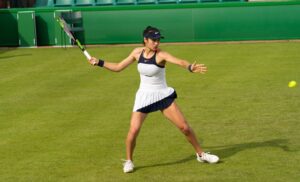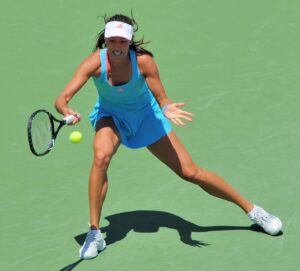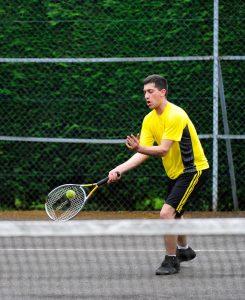We may earn money or products from the companies mentioned in this post.
Grand Slam Tournaments: The Ultimate Stage for Tennis Excellence

Tennis, a sport known for its grace, power, and precision, reaches its pinnacle at the Grand Slam tournaments These prestigious events are the epitome of excellence in the tennis world, bringing together the best players from around the globe to compete for glory and immortality
Definition of Grand Slam Tournaments
The term “Grand Slam” originated from the card game bridge, where it referred to winning all 13 tricks In tennis, a Grand Slam refers to winning all four major tournaments in a calendar year: the Australian Open, French Open (Roland Garros), Wimbledon, and US Open It is an incredibly rare feat that only a select few have achieved throughout history
Overview of the Four Grand Slam Events
Each Grand Slam tournament has its unique characteristics and traditions that make it special:
-
Australian Open:
Held annually in Melbourne since 1905, this tournament kicks off the tennis season in January Known for scorching temperatures and quick hard courts, it tests players’ endurance and adaptability -
French Open (Roland Garros):
Taking place on clay courts in Paris since 1891, this event demands stamina and finesse due to slow-paced rallies and tricky surface conditions It is considered the ultimate test of clay court prowess -
Wimbledon:
The oldest tennis tournament in the world dating back to 1877, Wimbledon is played on meticulously maintained grass courts With its rich history and traditional white dress code for players, it exudes elegance and charm -
US Open:
Held in New York City since 1881, the US Open is known for its vibrant atmosphere and hard courts It embraces innovation with night sessions and tiebreakers in all sets, adding an extra level of excitement to the matches
Importance of Court Surfaces in Tennis
One of the fascinating aspects of tennis is the variety of court surfaces players encounter throughout the season The choice of surface can significantly impact a player’s performance and playing style:
-
Hard Courts:
Hard courts are made from materials like concrete or asphalt covered with a synthetic/acrylic layer They provide a fast-paced game with consistent bounce, favoring powerful baseline shots -
Clay Courts:
Clay courts are made up of crushed brick or stone, offering a slower surface with high bounces Players require excellent footwork and patience to excel on clay, as rallies tend to be longer and more strategic -
Grass Courts:
Grass courts offer a unique playing experience with low bounce and quick movement Serve-and-volley players thrive on grass due to its fast nature, requiring swift reflexes and precise shot-making
The diversity of court surfaces adds an intriguing dimension to professional tennis, as players must adapt their game styles accordingly It also contributes to the unpredictability and excitement that fans love about the sport
The French Open: The Only Clay Court Grand Slam Tournament

Brief history of the French Open
The French Open, also known as Roland Garros, is one of the most prestigious tennis tournaments in the world With a rich history dating back to 1891, it has evolved into a Grand Slam event that attracts top players from all over the globe Originating as a national championship for France, it gradually gained international recognition and became open to international players in 1925
One of the defining features of the French Open is its venue – the iconic Roland Garros Stadium Named after World War I aviator Roland Garros, this historic stadium provides an awe-inspiring setting for some of the most intense battles on clay courts Its red clay surface adds another layer of difficulty and excitement to the tournament
Characteristics of clay courts
Clay courts have distinct characteristics that set them apart from other playing surfaces They are made up of crushed brick or stone, which gives them their unique reddish hue This composition creates a softer and slower surface compared to grass or hard courts
The impact on gameplay and strategy cannot be underestimated Due to the slower ball speed on clay courts, players need to adjust their timing and footwork accordingly The higher bounce off the surface poses an additional challenge as it can disrupt a player’s rhythm and require quick adjustments during rallies
One notable aspect of clay court matches is their tendency to produce longer rallies compared to other surfaces The nature of clay allows players more time to retrieve shots and engage in strategic baseline exchanges, testing both mental fortitude and physical endurance
Challenges faced by players on clay courts
Playing on clay courts presents unique challenges for tennis players One major challenge is adjusting to the different playing styles that clay favors The slower surface encourages defensive play and rewards patience, forcing players to develop a more versatile game that includes powerful groundstrokes and effective drop shots
In addition to adapting their style, players must also cope with the physical demands and endurance required on clay courts The slower pace of the game coupled with longer rallies can be physically taxing, necessitating exceptional fitness levels and stamina
In conclusion, the French Open stands as the only Grand Slam tournament played on clay courts, adding an element of unpredictability and excitement to the world of professional tennis With its rich history, iconic stadium, unique characteristics, and challenges faced by players, it continues to captivate audiences year after year
Notable Players and Moments in French Open History

Men’s Singles Champions and Records
When it comes to the French Open, one name that immediately comes to mind is Rafael Nadal Known as the “King of Clay,” Nadal has established his dominance on the red dirt with a staggering 13 titles at Roland Garros His relentless determination and unparalleled skill on clay have made him a force to be reckoned with, creating an era of tennis that will forever be associated with his name
Another legendary player who left an indelible mark on the French Open is Bjorn Borg The Swedish tennis sensation claimed six titles between 1974 and 1981, showcasing his exceptional talent and mental fortitude Borg’s remarkable achievements not only solidified his status as one of the greatest players of all time but also elevated the level of competition at Roland Garros
In addition to Nadal and Borg, there have been several other notable players who have graced the clay courts of the French Open Icons like Roger Federer, Novak Djokovic, Ivan Lendl, and Gustavo Kuerten have all left their mark with memorable performances throughout their careers
Women’s Singles Champions and Records
Chris Evert remains one of the most successful players in French Open history With a total of seven titles between 1974 and 1986, Evert showcased her impressive skills on clay year after year Her ability to adapt to different playing conditions and maintain her composure under pressure made her a formidable opponent at Roland Garros
In 1988, Steffi Graf achieved what no other player had done before – she completed a Golden Slam by winning all four Grand Slam tournaments in a single year, including the French Open Graf’s extraordinary feat solidified her place in tennis history and cemented her status as one of the all-time greats
Serena Williams, a name synonymous with excellence, has also enjoyed tremendous success at the French Open With three titles to her name, Williams’ powerful game and unwavering determination have produced memorable victories on the clay courts of Roland Garros
Memorable Matches in French Open History
The French Open has witnessed some unforgettable matches that have etched themselves into tennis folklore One such match took place in 1984 when John McEnroe faced Ivan Lendl in a thrilling five-set final The match was a battle of contrasting styles – McEnroe’s flair and touch versus Lendl’s relentless power Ultimately, it was Lendl who emerged victorious, capturing his first Grand Slam title
In 1999, Andre Agassi and Andrei Medvedev fought tooth and nail in an epic four-set final that captivated fans worldwide Agassi’s resilience and Medvedev’s sheer determination created a spectacle that showcased the beauty of clay court tennis In the end, it was Agassi who prevailed, claiming his first French Open crown
These are just a few examples of the countless incredible moments that have unfolded at the French Open over the years Each tournament brings its own share of drama, upsets, and triumphs, making it one of the most prestigious events in tennis
Conclusion

Comparison with other Grand Slam court surfaces
When comparing the French Open to the other three Grand Slam tournaments, it becomes evident that the clay-court surface adds a unique and challenging dimension to the game Unlike Wimbledon’s grass courts, which favor serve and volley players, or the hard courts of the Australian Open and US Open, which accommodate powerful baseline strokes, clay forces players to adapt their game style
The slower pace of play on clay requires patience and strategy, as players must rely more on precision and consistency rather than raw power The ability to slide into shots and construct points with crafty drop shots and topspin becomes crucial on this surface This stark contrast in playing conditions sets the French Open apart from its counterparts
The uniqueness of the French Open as a clay-court tournament
The French Open holds a special place in tennis history because it is the only Grand Slam tournament played on clay This distinction adds an air of mystique and intrigue to the event Clay is considered one of the most traditional surfaces in tennis, dating back centuries when matches were played on dirt courts
At Roland Garros, players not only battle against each other but also navigate through red dust clouds that swirl around during intense rallies The clay requires athletes to dig deep physically and mentally as they endure longer matches that test their endurance and shot-making abilities
Significance for players’ legacies
The French Open has immense significance for players’ legacies due to its demanding nature and historical importance Winning at Roland Garros showcases a player’s versatility and adaptability across different court surfaces It demonstrates their ability to conquer challenges presented by varying conditions
For many tennis legends, securing victory at the French Open completes their career Grand Slam, a remarkable feat that solidifies their status as all-time greats The likes of Rafael Nadal and Chris Evert have left an indelible mark on the tournament’s history with their multiple victories on the clay courts
Moreover, winning the French Open multiple times can establish a player’s dominance on this unique surface Rafael Nadal’s unprecedented thirteen titles at Roland Garros stand as a testament to his clay-court prowess and contribute significantly to his legacy as one of the greatest tennis players of all time
In conclusion, the French Open’s clay-court surface sets it apart from other Grand Slam tournaments, offering a distinct challenge for players and adding to its historical significance This uniqueness contributes to the event’s allure and makes winning at Roland Garros a defining milestone in a player’s career
Useful Links

Greatest Clay Court Players in Tennis History
What Are The Different Types Of Tennis Court Surfaces
What Surfaces Are The 4 Grand Slams Played On?
Explore the 4 Types of Tennis Courts, From Clay to Synthetic
HISTORY OF TENNIS COURTS
What is it about French Open clay that makes for surprises?
Types of Tennis court surfaces
What is it about French Open clay that makes for surprises?
Everything you need to know about tennis courts
What are the differences between the courts used …
Wimbledon is the only grass court Grand Slam
When the US Open was played on clay… – Laces Out
We Love You, Clay Court Tennis
French Open 2023: what are the tennis courts made from
Tennis For Beginners: What Are The Four Grand Slams
Grand Slams Archives
Roland Garros: Try the AP’s quiz about the clay-court …
Exploring the Vibrant Tapestry of Tennis Court Types
The characteristics of clay courts in tennis






